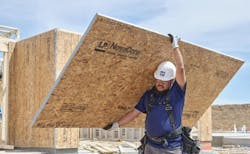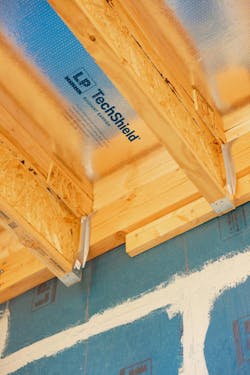3 reasons to consider green products for your next building project
In recent years, there has been a sharp focus on creating a more sustainable building industry. Several elements go into this: choosing the right products, prioritizing sustainability, and exceeding regulatory requirements. These elements work together to provide contractors, home builders, and building owners with a more sustainable future.
1. MEETING RISING DEMAND FOR SUSTAINABLE OPTIONS
Consumers are interested in purchasing sustainable products from sustainable brands. According to Nielsen, 75% of millennials are eco-conscious to the point of changing their buying habits to favor environmentally friendly products.
This dedication to sustainability goes far beyond consumer products, reaching into the building industry as well. The 2021 World Green Building Trends report confirmed that commitments to green building efforts remain strong — 34% of the surveyed companies in the U.S. were focused on building green, and 46% reported that they would do so in the next three years.
For builders and contractors, this signals an increased focus on using sustainable building products and practices. The construction industry is a massive consumer of raw materials and natural resources, generating an estimated 39% of the world’s carbon emissions, according to the World Green Building Council. This includes operational carbon — the ongoing carbon emissions from day-to-day use — and embodied carbon — all the carbon emitted in producing, transporting, and disposing of construction materials.
But change is on the horizon. Statista projects that the green building market is one of the fastest-growing industries worldwide.
As we look toward a greener future, builders and contractors will have a rich menu of green products to choose from to meet customer demand. According to a survey by Dodge Construction Network, more than 90% of U.S. engineering and construction companies receive requests from customers to lower the amount of embodied carbon used in construction projects.
Brands like LP Building Solutions are meeting this challenge by providing builders and contractors with certifiably sustainable building materials. All five eligible products in the LP Structural Solutions portfolio are verified as carbon-negative by ASTM International. In environmental product declarations produced by LP and verified by ASTM in September 2023, LP TechShield Radiant Barrier, LP WeatherLogic Air & Water Barrier, LP Legacy Premium Sub-Flooring, LP FlameBlock Fire-Rated Sheathing, and LP TopNotch 350 Durable Sub-Flooring were all proven to store more carbon than they generate throughout their life cycle — helping to reduce atmospheric carbon and generating greater value for customers, building owners and shareholders. In 2021, LP SmartSide Trim & Siding was verified as carbon negative in EPDs.
2. BUILDING FOR THE FUTURE: RESILIENCY IS SUSTAINABLE
The National Oceanic and Atmospheric Administration's National Centers for Environmental Information recently declared 2022 the third-worst year on record for the number of billion-dollar natural disasters in its Billion-dollar disaster report. Last year was also third highest in total costs, with at least $165 billion in damages. Future-minded builders and contractors are turning to resilient products to ensure that buildings can withstand varying climate events, especially in areas prone to extreme weather.
So, it’s more important than ever for builders and contractors to choose proven, premium products that instill confidence in the value of a client’s investment. Premium options pair all the benefits of traditional OSB with additional performance capabilities to enhance resistance against common elements like moisture, heat, fire, and air.
For example, LP NovaCore Thermal Insulated Sheathing helps structures against heat loss and gain, while LP FlameBlock Fire-Rated Sheathing is ideal for multifamily projects because it combines proven flame-spread and burn-through resistance with the strength of OSB in one pane. Using products like these provides building owners with proven resilience to environmental factors and severe weather, creating structures that are built to last.
3. GOING BEYOND REGULATORY REQUIREMENTS
Local, state, and federal building codes and regulations are a major factor in driving the industry in a sustainable direction. Clients increasingly want to work with construction firms that are focused on building for the future by not only meeting but exceeding regulatory standards.
Happily, there are there are thousands of green products on the market that can help achieve higher ratings within green building certification programs like LEED and the WELL Building Institute’s WELL Building Standard. Carbon-negative products like those from the LP Structural Solutions portfolio can help achieve these certifications.
One specific way that some states are prioritizing sustainability with code updates is by requiring higher insulation R-value to promote energy efficiency. The R-value can be achieved with cavity insulation alone or cavity insulation plus continuous insulation. While there may be occasional resistance to changing codes, the need for energy efficiency in heating and cooling buildings is here to stay.
Products that make meeting these codes easier, like LP NovaCore Thermal Insulated Sheathing, can give builders and contractors one of the most sustainable structural options portfolios on the market, to help exceed building codes.
As the building industry continues to move in a greener direction, we will continue to see shifts in sustainable building products and practices. It is the responsibility of everyone in construction – manufacturers, builders, contractors, and building owners – to prioritize sustainability in the building industry to ensure a better future for everyone.
ABOUT THE AUTHOR
Casey Smyth, brand manager for LP Building Solutions, headed the recent project that found the LP Structural Solutions portfolio to be carbon negative. A graduate of the University of Iowa, he holds an MBA from Vanderbilt University’s Owen Graduate School of Management.

